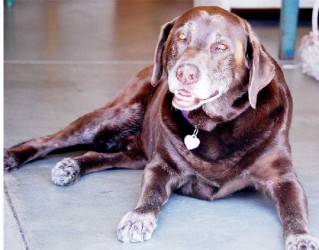Over the last few weeks we have been writing about the preferred feeding regimes of puppies, young adults, pregnant and lactating bitches, etc. Let us turn our thoughts today to the nutrition of our elderly canine wards. Later in future columns, we will deal in more detail with the general care of the elderly dog (canine geriatrics).
Since an older dog is less active, he needs fewer calories than when he was younger.
Without a reduction in the number of calories offered in the food,
Calories (energy) requirements for the older dog have to be determined on an individual basis. You must take into consideration your dog’s ideal weight (ie, the weight at which he is neither too fat nor too thin), how active he is, and what his emotional make-up may be. Highly-strung dogs require more food than their more sedate counterparts.
In general, an elderly dog of average size needs only about 25 to 30 calories per pound body weight per day. Canned dog foods supply about 500 calories in a pound of ration; moist or ‘chunky’ dog food about 1300 calories; and dry kibble about 1600 calories.

While high quality protein is important for the older dog, he should not be fed a diet too rich in meat or one containing protein of poor quality. This creates an increased nitrogen load which must be handled by the old dog’s old liver and kidneys. Dogs with weak kidneys can experience kidney failure by feeding them more protein than they can handle.
Energy needs are better met by giving easily digestible carbohydrates – cooked to break down starch granules. High quality protein suitable for the digestive tract of an older dog can be supplied by adding small amounts of cooked mince, boiled egg, cottage cheese, or skimmed milk to a kibble base. If your dog seems to be losing weight or appears to need more calories, try adding small amounts of carbohydrate (cooked cereals, cooked rice, or farina).
While fats increase the palatability of food, they are difficult for the older dog to digest and are high in calories. Some fat is required to aid the intestinal absorption of vitamins, and to provide for the manufacture of essential fatty acids, but adequate amounts are supplied by commercial dog foods. Fats supplements should not be added to the ration.
Old dogs need more minerals and vitamins. B vitamins are lost in the urine of dogs having reduced kidney function; also, absorption of vitamins through the intestinal tract decreases as the individual ages. Calcium and phosphorus in correct balance (1.2 to 1) helps to prevent softening of the bones.
Therefore, many old dogs probably need a vitamin/mineral supplement. But it should be balanced to meet the metabolic needs. Your veterinarian can recommend an appropriate supplement to meet the specific requirements of your dog. If you use a commercial pet food especially formulated for older dogs, you may not need to add vitamins and minerals unless there is a specific medical reason to do so.
It is desirable when feeding the older dog to divide his daily ration into two equal parts and feed the first half in the morning and the second in the evening.
Next week we will add to the discussion (on canine nutrition) the different types of commercial dog/cat food on the market.
The above has been taken largely from a book on animal care by Drs Carlson and Giffin.
Please implement disease preventative measures (vaccinations, routine dewormings, monthly anti-heartworm medication, etc) and adopt-a-pet from the GSPCA’s Animal Clinic and Shelter at Robb Street and Orange Walk, if you have the wherewithal to care well for the animals. Do not stray your unwanted pets, take them to the GSPCA’s Clinic and Shelter instead. If you do not wish your pet to have puppies or kittens, you may exploit the GSPCA’s free spay and neutering programme. If you see anyone being cruel to an animal, or if you need any technical information, please get in touch with the Clinic and Shelter by calling 226-4237.





